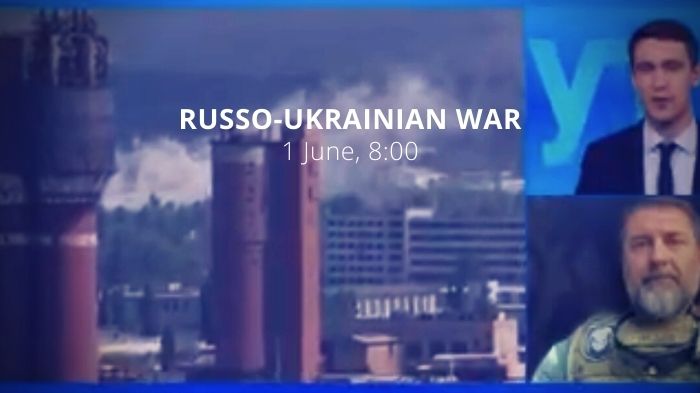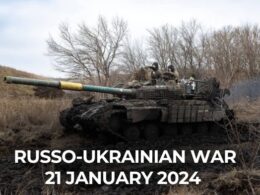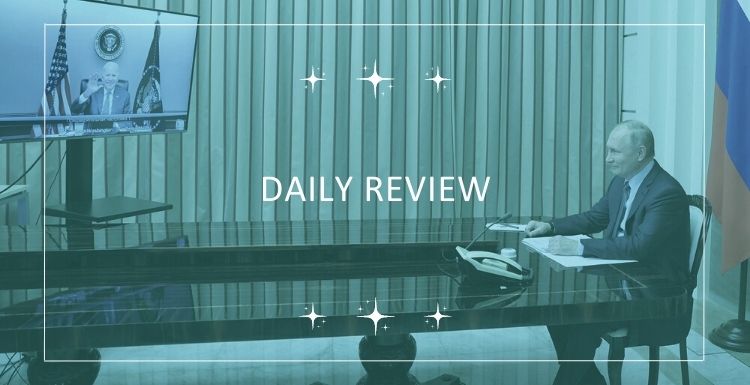Russia controls 70% of Sievierodonetsk, stalls offensive in other parts of Donbas. Ukraine counterattacks in Mykolayiv Oblast. Russia strikes back at Ukrainian counteroffensive in Kherson Oblast; a rapid advance there is unlikely before Ukraine gets more weapons. Russia likely exploits Belarus stocks to compensate for loss of military equipment. Two Russians sentenced for shelling Kharkiv Oblast. Biden does not encourage Ukraine to strike beyond its borders, wants a “negotiated end” to Russo-Ukrainian war. Chairman of the US Joint Chiefs of Staff says using military to end Russia’s food blockade is too “high risk.” UN discusses exporting Russian grain and fertilizer to global markets.
Morning report day 98 – June 01. Situation
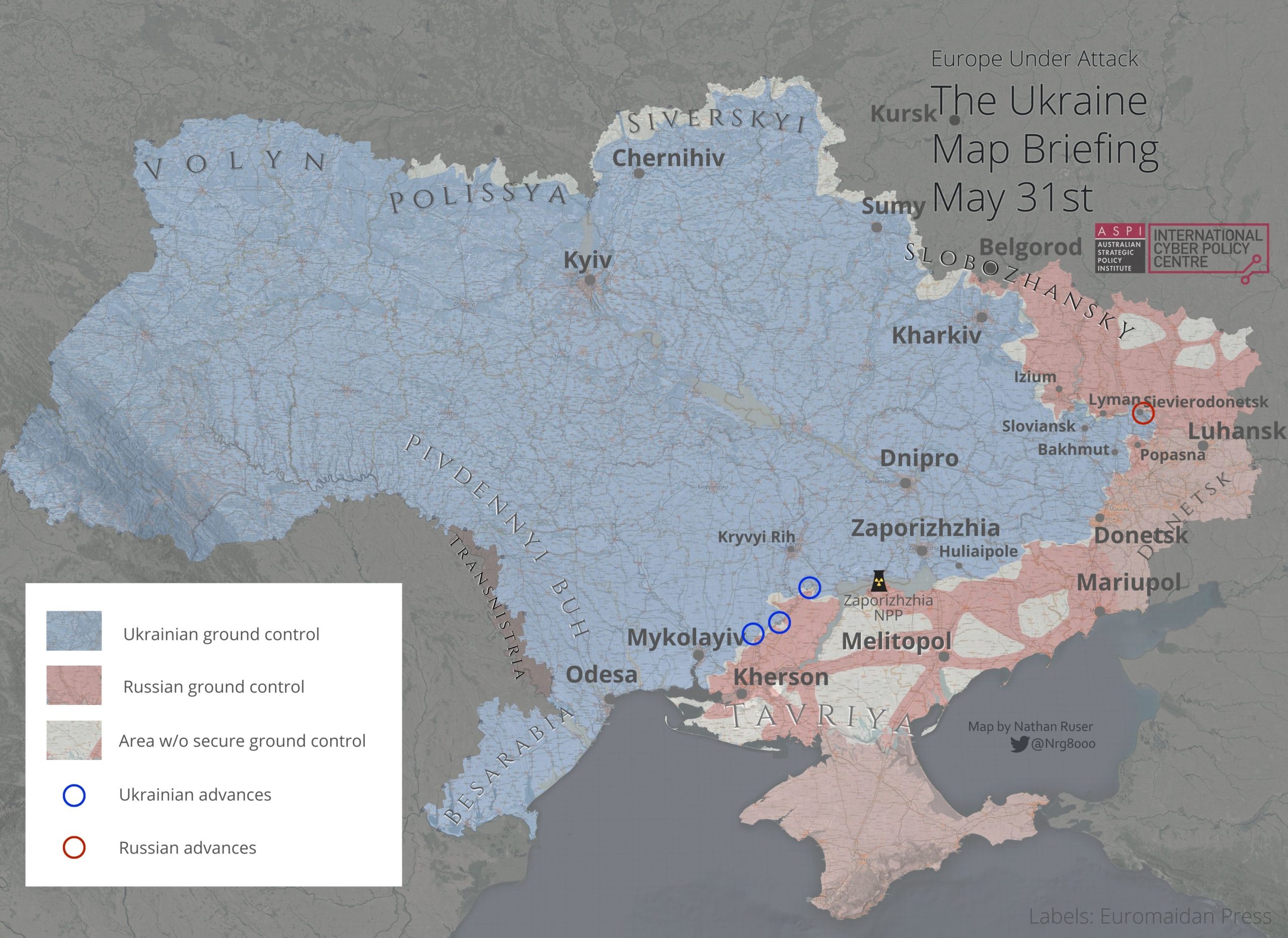
An overview of the situation based on observations of military analyst Roman Ponomarenko.
Fighting continues in Luhansk and Kherson Oblasts.
Luhansk Oblast: street fights in Sievierodonetsk continue for the third day. The Russians moved forward and report on the capture of most of the city. The intentions of Ukraine’s command are unknown: there are rumors both stating that reinforcements are transferred to Sievierodonetsk and that the Ukrainian Army is gradually retreating to Lysychansk, imposing deterrent, rear-guard battles on the enemy. In any case, the possible loss of Sievierodonetsk will not be a catastrophe and will not lead to a crisis at the front.
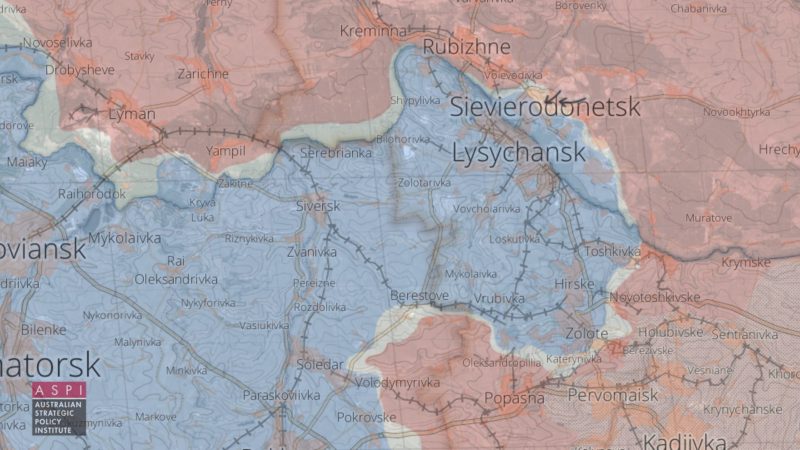
Russia’s offensive in three directions from Popasna continues to slow down, and Ukrainian forces hold the front in Bakhmut and Soledar. Russia continues to shell the “lifeline” Bakhmut-Lysychansk road but cannot block it. The battle for Komyshuvakha (between Zolote and Vrubivka) has been going on for almost three weeks, and the Russians cannot capture it. The Ukrainian garrison in Zolote, surrounded on three sides, continues to hold its ground. The fighting continues, Russians suffered heavy losses, with only 25% of personnel and 20% of equipment remaining in most of the available BTGs in this area, and continue to transfer reinforcements in this direction.
Kherson Oblast: rumors continue to spread about a massive Ukrainian offensive from the Davydiv Brid area to the south, to Nova Kakhovka. There is no serious evidence of this. What is well known is that three days ago the Ukrainian Armed Forces broke through the Russian 49th Army’s defense front near the village of Davydiv Brid and skillfully struck from the rear at the Russian fortified area west of it, near the village of Bila Krynytsia, which was destroyed. And they allegedly advanced 9 km deep into the occupied territory to the village of Bruskynske, which, however, was not liberated. That’s all.
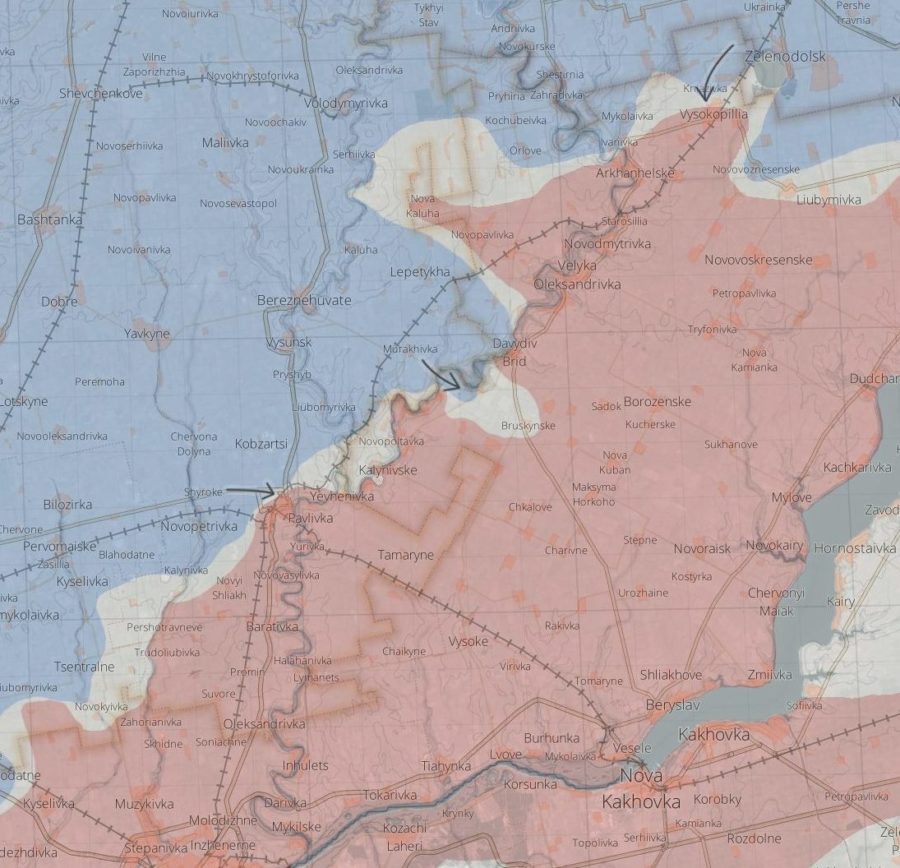
We must understand that there will be no rapid advance of Ukrainian troops deep into the Kherson region. The American M777 howitzers that contributed to Ukraine’s initial success are not as numerous as hoped for. The Russians maintain an advantage in the air, for example, they launched an airstrike on Ukrainian troops in Davydiv Brid today. And two lines of fortifications were built around Kherson and now a third is being built. Approaches to other key Russian-held points, including Nova Kakhovka, are also being strengthened. It is in this sense that President Zelenskyy stated that Ukraine will not rush to deoccupy the territories if it requires tens of thousands of victims, but will wait for the necessary weapons from the West.
In parallel with the Kherson Oblast, Ukrainian forces have tried to advance on Snihurivka (near Pavlivka) in Mykolayiv Oblast, but have so far failed to liberate this town.
Russians claim that a few days ago, a Ukrainian sabotage group invaded the Bryansk Oblast, killing six Russian border guards. Ukraine ignores all these statements, possibly not to irritate its Western partners who are very stressed about the possibility of a transfer of hostilities to Russian territory and the destruction of facilities in the depths of Russia. Despite more than three months of war in Ukraine, many Western leaders continue to talk about “preventing escalation” and are ringing Putin’s phone off the hook, talking to him for hours to no avail.
Information from the General Staff as of 06.00 01.06.2022, supplemented by its [18:00 assessment], is below.
“In the Volyn and Polissya directions, units of the Armed Forces of the Republic of Belarus continue to perform tasks to strengthen the protection of the Ukrainian-Belarusian border in the Brest and Gomel regions. Measures are being taken to check the combat readiness of certain units and military units. [No signs of enemy offensive formations were found.]
- [The removal of tanks and infantry fighting vehicles from the storage bases of the Republic of Belarus was noted. Their further transfer to the armed forces of the Russian Federation to make up for current losses is not ruled out.]
In the Siversky direction, Russian forces units are conducting engineering equipment of positions in the areas of some settlements of the Bryansk region, at a distance of about 3 km from the State Border of Ukraine.
- [Russian forces did not take active action, and no signs of offensive formation were found. In order to demonstrate the presence and prevent the transfer of units of the Defense Forces to other areas, it keeps some Russian forces in the border areas of the Bryansk and Kursk regions.]
- [Russian forces launched a missile at Ukrainian units in the Sumy oblast from Su-30SM aircraft. Artillery and mortar shelling of border settlements continues.]
- Russian aggressor fired a Su-35 missile at Bilopillya, Sumy oblast. Artillery fire caused damage in the area of the settlement of Seredyna-Buda, Sumy oblast.
In the Slobozhansky direction, Russian forces continued to focus their efforts on maintaining their positions and conducting reconnaissance.
- In the Kharkiv direction, Russian forces fired at the settlements of Oleksandrivka, Slatyne, and Tsyrkuny by MLRS and artillery. It launched helicopter attacks in the areas of the settlements of Vesele and Ternov.
- In the Sloviansk direction, Russian forces regrouped. As a result of losses in the Dovhenkyi district, it took some units to the city of Izium for reconstruction. To strengthen the protection and defence of logistics routes, it strengthened the group in the village of Kupiansk by moving the battalion tactical group. It conducted reconnaissance of the positions of our troops with the help of the Orlan-10 UAV in the areas of Izium, Pervomaisky and Velyka Komyshuvakha.
- [Russian forces are preparing to resume the offensive in the areas of Izium and Sloviansk.]
In the Donetsk direction, Russian aggressor’s units, with the support of the air force, are focusing their efforts on conducting offensive operations. To inflict losses and deplete the personnel of our troops, Russian forces fired along the line of contact from mortars, artillery and multiple rocket launchers. Repaired the railway bridge crossing in the area of the settlement of Kupiansk to restore the logistics supply of the railway branch Kupiansk – Lyman.
Russians control 70% of Sievierodonetsk – Luhansk Oblast Head Serhii Haidai
He says that part of the Ukrainian troops retreated to more advantageous prepared positions while another part – continues fighting inside the cityhttps://t.co/BlHjA59sCk pic.twitter.com/Xoop6ajbc1
— Euromaidan Press (@EuromaidanPress) June 1, 2022
- In the Lyman direction, Russian forces reinforced units and regrouped them. With the support of Ka-52 helicopters, the offensive is in the direction of the Lyman -Stary Karavan, and the fighting continues.
- In the Sievierodonetsk direction, Russian forces carried out assault operations in the northern, southern and eastern districts of the city of Sievierodonetsk. [They are trying to establish full control over the settlement and surround the units of the Defense Forces operating in this direction. Prepares for the offensive in the areas of Siversk and Raihorodok.]
- In the Bakhmut direction, Russian forces are trying to oust Ukrainian troops from their positions in the Belogorovka and Vrubivka districts. It used assault and army aircraft in the settlements of Komyshuvakha, Berestov and Nyrkove.
- [In the Kurakhiv direction, Russian forces did not conduct active hostilities and carried out artillery attacks on Ukrainian troops.]
- In the Zaporizhzhia direction, Russian forces carried out engineering work to improve the fortifications of the second line of defence. He relocated to the area of Vasylivka settlement to the T-62 tank battalion and the motorized rifle battalion.
- In the Avdiivka, Kurakhivka and Novopavlivka directions, Russian forces hold their occupied positions, inflicting fire damage with mortars and artillery.
- [In other areas, they continue to fire to restrain the actions of Ukrainian troops and prevent them from being transferred to other, threatening areas.]
In the Pivdennyy Buh direction, Russian forces’ main efforts are focused on maintaining the occupied positions and creating additional lines of defence. In the areas of the settlements of Mykolayivka, Novopavlivske and Shyroke, it carried out massive shelling from multiple rocket launchers, artillery and mortars. [Russian forces are defending and mining the coast of the Inhulets River in areas of possible action by units of our troops. Conducts a counter-battery fight. Inflicted airstrikes with the involvement of army aircraft in the area of the settlement of Davydiv Brid, Kherson oblast.]
[In the waters of the Black Sea and the Sea of Azov, the Black Sea Fleet continues to perform tasks to isolate combat areas. The frigate Admiral Makarov is on station with up to 8 Caliber cruise missiles on board, ready for use.]
- The storm tore 2 enemy naval mines from the anchor. One was carried by the waves to the shores of Odesa, where it was neutralized by specialists of the Navy subversive team, the other was blown up by our soldiers just at sea.
In the past 24hrs, nine enemy attacks have been repulsed in Donetsk and Luhansk, two tanks, thirteen artillery systems, eight armoured fighting vehicles and six enemy vehicles have been destroyed. In the South, in the Kherson and Mykolaiv oblasts, the losses of the Russian occupiers, in addition to military equipment, amounted to about seventy people.
[Russian forces are demoralized, suffering losses, and in some areas hastily moving to the defence. Defenders of Ukraine continue to defend our land and gradually displace the invaders from the temporarily occupied territories of Ukraine.]”
Enemy controls most of Sievierodonetsk, but the city is not encircled, Ukrinform reports. “Most of Sievierodonetsk is controlled by the Russians. The city is not surrounded, and there are no prerequisites for this. Critical infrastructure in the city is almost 100% destroyed, the housing stock is 90% damaged, and 60% of buildings are seriously damaged, that is they cannot be restored, Serhii Haidai, head of the Luhansk Regional Military Administration, said this on Telegram. Due to the shelling, it is impossible to bring humanitarian goods to Sievierodonetsk, as well as to evacuate people.”
Russian strike hits nitric acid tank at chemical plant in Sievierodonetsk
Nitric acid is dangerous if inhaled, swallowed, & in contact with skin. Residents are urged to stay in shelters & prepare protective face masks – RegAdm Head Serhiy Haidai https://t.co/J2YZhXabg2 pic.twitter.com/O9kXI8UYWw
— Euromaidan Press (@EuromaidanPress) May 31, 2022
US Department of State: Russia’s objectives of controlling occupied territories of Ukraine fail, Ukrinform reports.
“Russia’s initial objectives of controlling large swaths of Ukraine has been nothing short of a complete failure. The Kremlin probably views that forcibly holding Kherson would provide Russia with a land bridge to Crimea, as well as gaining some kind of so-called victory and attempt to justify Russia — to Russia’s domestic audiences — [of] the thousands of lives Putin’s war of choice has destroyed, US State Department spokesperson Ned Price said Tuesday, CNN reports. He stressed that the Kremlin’s proxies could not gain any legitimacy in the occupied territories.
Russia is almost certainly failing to gain legitimacy for proxy governments in newly seized territories in Ukraine, as protests persist, and residents refuse to cooperate, Price added. Price noted that the United States remains “concerned about steps Russia is taking to attempt to institutionalize control over sovereign Ukrainian territory, particularly in Ukraine’s Kherson region. The Kremlin is probably weighing a few approaches, from recognizing a so-called People’s Republic, as Russia forcibly did in Donetsk and Luhansk, to an attempted annexation, just as Russia did in Crimea, the US State Department spokesperson summed up.”
According to British Defence Intelligence, (last 24 hours):
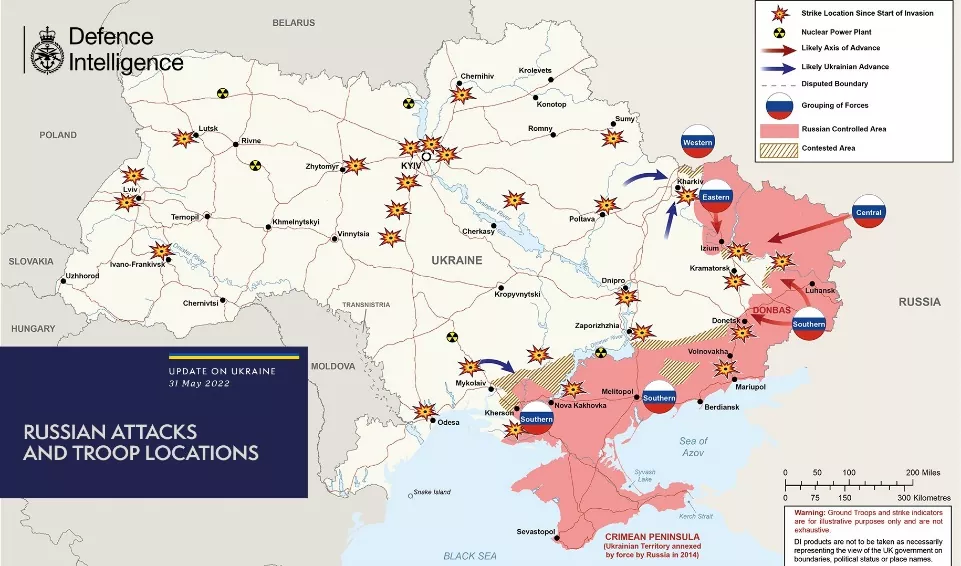
- Russian ground operations remain tightly focused, with the weight of fire power concentrated within a small sector of Luhansk Oblast. Over 30-31 May, fighting intensified in the streets of Sievierodonetsk, with Russian forces pushing closer to the town centre. Over half of the town is likely now occupied by Russian forces, including Chechen fighters.
- Beyond the Donbas, Russia continues to conduct long-range missile strikes against infrastructure across Ukraine. The strategically important bridge links Ukraine with Romania and with Ukraine’s ports on the Danube, which have become critical to Ukrainian exports after the blockade of Ukrainian Black Sea ports by Russia.
As of Wednesday 1 June, the approximate losses of weapons and military equipment of the Russian Armed Forces from the beginning of the war to the present day:
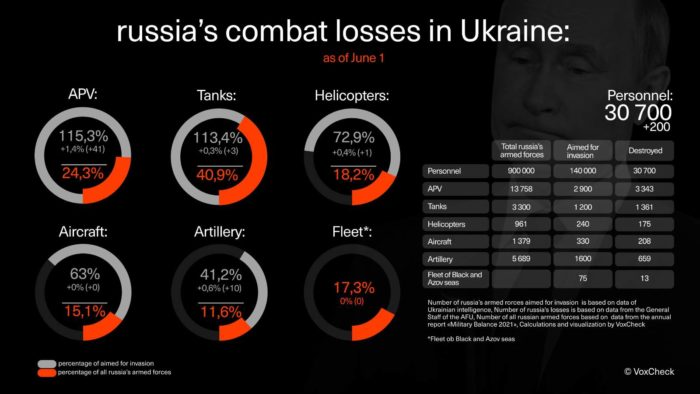
- Personnel – more than 30700 (+200),
- Tanks – 1361 (+3),
- Armoured combat vehicles – 3343 (+41),
- Artillery systems – 659 (+10),
- Multiple rocket launchers –MLRS – 207 (+0),
- Air defence means – 94 (+1),
- Aircraft – 208 (+0),
- Helicopters – 175 (+1),
- Automotive technology and fuel tanks – 2290 (+15),
- Vessels/boats – 13 (+0),
- UAV operational and tactical level – 519 (+4),
- Special equipment – 49 (+1),
- Mobile SRBM system – 4 (+0),
- Cruise missiles – 120 (+0)
Russian enemy suffered the greatest losses (of the past day) at the Kryvyi Rih and Bakhmut directions.
Humanitarian
The Verkhovna Rada fired Ombudsperson Denisova, Ukrayiska Pravda reports. The Verkhovna Rada fired Liudmyla Denisova, the Parliamentary Commissioner for Human Rights. There was no new appointment at the Parliament’s meeting on 31 May.
Ukraine working on an UN-led operation to export food, Ukrinform reports.
“Russia plays hunger games with the world by blocking Ukrainian food exports with one hand and trying to shift the blame on Ukraine with the other. Ukraine is working on an international UN-led operation with navies of partners ensuring a safe trade route with no security risks, Minister of Foreign Affairs of Ukraine Dmytro Kuleba posted on Twitter.
Due to the blockade of Ukrainian seaports, 7 million tonnes of wheat, 14 million tonnes of corn grain, 3 million tonnes of sunflower oil, and 3 million tonnes of sunflower meal are unable to reach the global market. This has already led to a record rise in global market prices and will inevitably result in a global food crisis and rising inflation.”
With a food crisis looming, Milley says using the military to end the Russian blockade would be ‘high risk’, Defence News reports.
You can take the grain out by truck or train, or you can take it out by the sea. Right now, the sea lanes are blocked by mines and the Russian navy. In order to open up those sea lanes would require a very significant military effort, Milley said. If policymakers opted for it, it would be a high-risk military operation that would require significant levels of effort.
US President Joe Biden has committed to defending NATO and coordinated weapons shipments to Ukraine but has resisted other calls for US troops to get involved as he seeks to avoid coming into direct conflict with Russia and sparking a wider war. In March, Biden opted against a no-fly zone sought by Ukrainian President r Zelensky because Biden deemed it escalatory.
Retired Adm. James Stavridis, a former supreme allied commander of NATO, argued this week that ships under the auspices of the United Nations, NATO or a coalition of nations could escort convoys of grain as US naval vessels escorted oil shipments in the 1980s, amid tensions with Iran.”
Hans Petter Midttun: The General should listen to the Admiral. His statement that “You can take the grain out by truck or train, or you can take it out by the sea” is highly inaccurate. Transport over land will only allow for the export of a fraction of what is stored. Additionally, it does not reflect the time issue and storage challenge as this year’s harvest is about to arrive before last year’s harvest has been moved.
According to UNHCR 6,801,987 refugees have been registered as of May 29 (no update). The UN says that so far Poland has taken in 3,627,178 refugees, Romania 989,357, Russian Federation 971,417, Hungary 682,594, Republic of Moldova 479,513, Slovakia 461,164 and Belarus 30,092. Among those who fled Ukraine are also Ukrainian nationals with dual citizenship. An additional 105,000 people moved to the Russian Federation from the Donetsk and Luhansk regions between 18 and 23 February.
The number of Ukrainians entering Ukraine since February 28 is 2,229,500 as of May 27. This figure reflects cross-border movements, which can be pendular, and does not necessarily indicate sustainable returns.
OHCHR recorded 9,029 civilian casualties in Ukraine as of May 30. 4,113 were killed (including 264 children) and 4,916 injured (including 421 children).
Environmental
UN had ‘constructive’ talks in Moscow on Russian grain, and fertilizer exports, Reuters reports. “A senior UN official had “constructive discussions” in Moscow with Russian First Deputy Prime Minister Andrei Belousov on facilitating Russian grain and fertilizer exports to global markets, UN spokesman Stephane Dujarric said on Tuesday.
The UN official, Rebecca Grynspan, is now in Washington for talks on the same issue “with the key aim of addressing growing global food insecurity,” Dujarric said.
US Ambassador to the United Nations Linda Thomas-Greenfield said the United States is prepared to give “comfort letters” to shipping and insurance companies to help facilitate exports of Russian grain and fertilizer.
She noted that Russian grain and fertilizer were not directly sanctioned by the United States but that “companies are a little nervous and we’re prepared to give them comfort letters if that will help to encourage them.”
UN Secretary-General Antonio Guterres, who visited Moscow and Kyiv last month, is trying to broker what he calls a “package deal” to resume both Ukrainian food exports and Russian food and fertilizer exports.
Russia’s war in Ukraine has fueled a global food crisis with prices for grains, cooking oils, fuel and fertilizer soaring. Russia and Ukraine account for nearly a third of global wheat supplies, while Russia is also a key fertilizer exporter and Ukraine is a major exporter of corn and sunflower oil.”
Legal
Between 200 and 300 war crimes are committed in Ukraine every day – Venediktova, Ukrainska Pravda reports. “Every day, between 200 and 300 war crimes are committed in Ukraine… It is a brutal war. We do not have access to the occupied territories, but I hope that thanks to our international colleagues, we will be able to achieve justice, Venediktova, Office of the Prosecutor General, said according to Ukrinform.
“A joint press conference with the Prosecutor of the International Criminal Court, Karim Khan, and the Prosecutor General of Ukraine, Iryna Venediktova, took place on 31 May in The Hague. The Prosecutor General emphasised that military hostilities are constantly taking place in Ukraine. The Office of the Prosecutor General reported that Estonia, Latvia and Slovakia have joined the Joint Investigation Group to investigate serious international crimes in Ukraine.”
Invaders deport children from Mariupol and Volnovakha to Rostov Oblast, Russia: they want to turn them into Russian citizens, Ukrainska Pravda reports. Russian invaders have taken 267 orphans from Mariupol and Volnovakha to Rostov Oblast, Russia.
“The children are being kept at the Romashka sports and recreation complex, which is located in the village of Zolotaya Kosa in the Neklinovsky district [near Taganrog], reported Petro Andriushchenko, adviser to the mayor of Mariupol. According to Andriushchenko, the Russians have deported a total of 540 orphaned children from Donetsk Oblast. The transported children are being prepared to become citizens of the Russian Federation under a simplified procedure which was recently signed into law by Russian dictator Vladimir Putin.”
Two Russians were sentenced to 11.5 years for shelling the Kharkiv Oblast, Ukrainska Pravda reports. “A court in Poltava Oblast has sentenced two Russian servicemen, Aleksandr Bobykin and Aleksandr Ivanov, to 11 years and six months in prison for shelling civilian areas of the Kharkiv region.”
Russian Soldiers Send Home 58 Tons of Looted Items from Ukraine, The Moscow Times reports. Russian soldiers fighting in Ukraine have sent home at least 58 metric tons of looted goods since the start of the invasion in late February, according to an investigation published by independent news site Mediazona.
“The outlet analyzed packages sent from 46 branches of delivery firm SDEK located close to the Ukrainian border in Russia and Belarus, as well as in the annexed Crimea. Parcels allegedly sent by Russian soldiers were often identified by their weight, with each package usually exceeding the size of an average parcel several times over. Mediazona found that the largest number of parcels were sent between late March and early April — right after the Russian troops left their positions in northern Ukraine and near the capital Kyiv. On 4 April alone, soldiers sent 4 tons of parcels believed to be full of looted goods.”
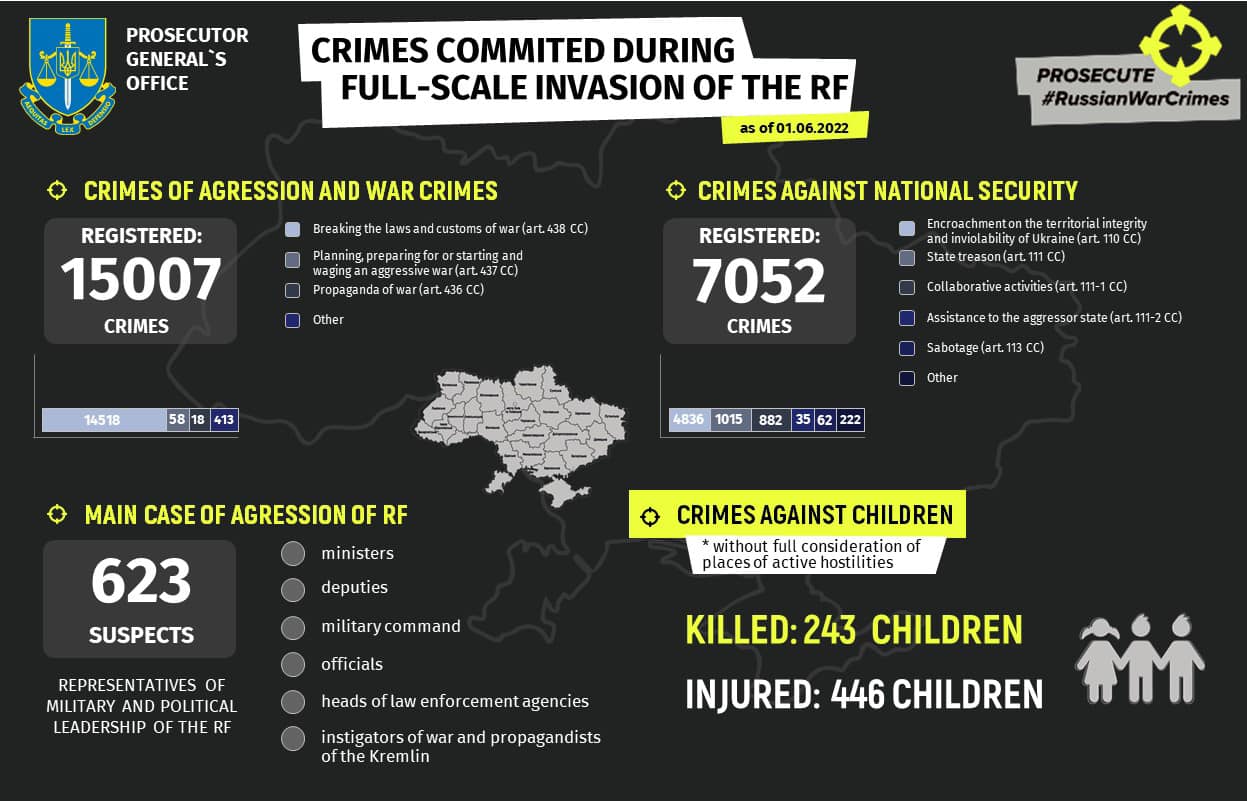 243 children were killed, and 446 children injured, the Office of the Prosecutor General of Ukraine reports as of June 1. 1,937 educational establishments are damaged as a result of shelling and bombings, 181 of them are destroyed fully. 15,007 crimes of aggression and war crimes and 7,052 crimes against national security were registered.
243 children were killed, and 446 children injured, the Office of the Prosecutor General of Ukraine reports as of June 1. 1,937 educational establishments are damaged as a result of shelling and bombings, 181 of them are destroyed fully. 15,007 crimes of aggression and war crimes and 7,052 crimes against national security were registered.
Support
President Biden: What America Will and Will Not Do in Ukraine, as published by The New York Times.
America’s goal is straightforward: We want to see a democratic, independent, sovereign and prosperous Ukraine with the means to deter and defend itself against further aggression.
As President Volodymyr Zelensky of Ukraine has said, ultimately this war “will only definitively end through diplomacy.” Every negotiation reflects the facts on the ground. We have moved quickly to send Ukraine a significant amount of weaponry and ammunition so it can fight on the battlefield and be in the strongest possible position at the negotiating table.
That’s why I’ve decided that we will provide the Ukrainians with more advanced rocket systems and munitions that will enable them to more precisely strike key targets on the battlefield in Ukraine.
We will continue cooperating with our allies and partners on Russian sanctions, the toughest ever imposed on a major economy. We will continue providing Ukraine with advanced weaponry, including Javelin anti-tank missiles, Stinger antiaircraft missiles, powerful artillery and precision rocket systems, radars, unmanned aerial vehicles, Mi-17 helicopters and ammunition. We will also send billions more in financial assistance, as authorized by Congress. We will work with our allies and partners to address the global food crisis that Russia’s aggression is worsening. And we will help our European allies and others reduce their dependence on Russian fossil fuels, and speed our transition to a clean energy future.
We will also continue reinforcing NATO’s eastern flank with forces and capabilities from the United States and other allies. And just recently, I welcomed Finland’s and Sweden’s applications to join NATO, a move that will strengthen overall US and trans-Atlantic security by adding two democratic and highly capable military partners.
We do not seek a war between NATO and Russia. As much as I disagree with Mr. Putin, and find his actions an outrage, the United States will not try to bring about his ouster in Moscow. So long as the United States or our allies are not attacked, we will not be directly engaged in this conflict, either by sending American troops to fight in Ukraine or by attacking Russian forces. We are not encouraging or enabling Ukraine to strike beyond its borders. We do not want to prolong the war just to inflict pain on Russia.
My principle throughout this crisis has been “Nothing about Ukraine without Ukraine.” I will not pressure the Ukrainian government — in private or public — to make any territorial concessions. It would be wrong and contrary to well-settled principles to do so.
Ukraine’s talks with Russia are not stalled because Ukraine has turned its back on diplomacy. They are stalled because Russia continues to wage a war to take control of as much of Ukraine as it can. The United States will continue to work to strengthen Ukraine and support its efforts to achieve a negotiated end to the conflict.
Unprovoked aggression, the bombing of maternity hospitals and centers of culture, and the forced displacement of millions of people makes the war in Ukraine a profound moral issue. I met with Ukrainian refugees in Poland — women and children who were unsure what their lives would be, and whether the loved ones who stayed behind in Ukraine would be OK. No person of conscience could be unmoved by the devastation of these horrors.
Standing by Ukraine in its hour of need is not just the right thing to do. It is in our vital national interests to ensure a peaceful and stable Europe and to make it clear that might does not make right. If Russia does not pay a heavy price for its actions, it will send a message to other would-be aggressors that they too can seize territory and subjugate other countries. It will put the survival of other peaceful democracies at risk. And it could mark the end of the rules-based international order and open the door to aggression elsewhere, with catastrophic consequences the world over.
I know many people around the world are concerned about the use of nuclear weapons. We currently see no indication that Russia has intent to use nuclear weapons in Ukraine, though Russia’s occasional rhetoric to rattle the nuclear saber is itself dangerous and extremely irresponsible. Let me be clear: Any use of nuclear weapons in this conflict on any scale would be completely unacceptable to us as well as the rest of the world and would entail severe consequences.
Americans will stay the course with the Ukrainian people because we understand that freedom is not free. That’s what we have always done whenever the enemies of freedom seek to bully and oppress innocent people, and it is what we are doing now. Vladimir Putin did not expect this degree of unity or the strength of our response. He was mistaken. If he expects that we will waver or fracture in the months to come, he is equally mistaken.
Biden said what America will do in Ukraine. Here is what he forgot to say.
Biden admin will provide Ukraine with longer-range rocket systems, NBC News reports. A senior official said Tuesday that Ukraine had agreed not to use the new longer-range rocket systems, called MLRS, to fire rockets into Russia. President Joe Biden said Tuesday that he would “provide the Ukrainians with more advanced rocket systems and munitions that will enable them to more precisely strike key targets on the battlefield in Ukraine.”
The White House National Security Council said Tuesday that the “more advanced rocket systems” were longer-range Multiple Launch Rocket Systems, or MLRS. They are capable of reaching Russia, said officials, but are not intended to fire rockets into Russia or be used outside of Ukraine. A senior administration official said Ukraine has agreed not to use them to launch rockets into Russia. The senior official said the package would be for $700 million and would also include more systems and weapons that the US has already provided Ukraine, including more Javelin missiles.
Berlin to supply arms to Greece, Athens to deliver Soviet weapons to Kyiv -Scholz, Reuters reports. “Germany will deliver infantry fighting vehicles (IFV) to Greece so that the government in Athens can pass on Soviet-style weapons to Ukraine, German Chancellor Olaf Scholz said on Tuesday. Scholz gave no details as to what kind of infantry fighting vehicles Berlin will hand over to Greece – or what kind of weapons Athens will pass on to Kyiv.
According to a defence source, Berlin aims to deliver some 100 old Marder IFVs owned by arms-maker Rheinmetall (RHMG.DE) to Greece. Athens, in return, would supply Soviet-style BMP IFVs to Ukraine, the source told Reuters.”
How the War Changed the Way Ukrainians Think About Friends, Enemies, and the Country’s Strategic Goals – an opinion poll by Ilko Kucheriv Democratic Initiatives Foundation (DIF). Compared to the first half of February 2022, support for Ukraine’s accession to the European Union increased by 16% among the population of the sampled western and central regions of Ukraine. Since the beginning of the war, support for NATO membership as the best option to ensure Ukraine’s security increased to 74% (+ 5% compared to February 2022) in the western and central regions of Ukraine.
The war has changed public opinion about the strongest allies of Ukraine. According to February 2021 poll, Ukraine’s top 3 allies included the United States (38%), Poland (35%) and Germany (28%). In May, of Ukrainians called Great Britain (66%), Poland (65%), and the United States (63%) as the strongest allies. in 2022. Favourable opinions of Germany as an ally (-14%), Georgia (-13%) and Belarus (-10%) decreased significantly.
The Russian leadership of Russia is held responsible for starting the war by 96% of the respondents. The majority (54%), however, see the Russian people as also responsible for the war. As of May, 78% were against any concessions to Russia.
In May 2022, 94% of citizens from the western and central regions believed in Ukraine’s victory. Among the respondents who are confident of Ukraine’s victory (78%), 41% define victory as the expulsion of Russian troops from all of Ukraine and a full restoration of control over the state borders. The same number of respondents (41%) believe that victory is the total defeat of the Russian army and assistance to an insurgency inside Russia/disintegration of Russia.
New developments
- President Biden: What America Will and Will Not Do in Ukraine. The president has made his aim and objectives for his support for Ukraine public in an article published in The New York Times. Its content is outlined above.
- Ukraine doesn’t care about Russia’s plans for the country’s east – Zelensky, Ukrinform reports. “Ukraine does not care about Russia’s plans to capture the east of the Ukrainian state, timed with certain dates. All occupied territories will be liberated with the emphasis on preserving the lives of as many Ukrainian defenders as possible. At the same time, the head of state acknowledged that the situation in the east today is the most difficult due to the fact that the largest number of Russian equipment and military formations have been amassed there. In the east, we have a hard time because we lack (the sufficient number of) weapons,” Zelensky emphasized”.
- Ukrainian PM and Slovak president discusses military assistance and EU integration, Ukrinform reports. Ukrainian Prime Minister Denys Shmyhal and Slovak President Zuzana Caputova at a meeting in Kyiv yesterday discussed support for Ukraine and the country’s European integration.
Assessment
1. On the War
The Institute for the Study of War has made the following assessment as of Tuesday 31 May:
The Ukrainian leadership has apparently wisely avoided matching Putin’s mistaken prioritization. Kyiv could have committed more reserves and resources to the defense of Sievierodonetsk, and its failure to do so has drawn criticism. Ukrainian forces are now apparently withdrawing from Sievierodonetsk rather than fighting to the end—a factor that has allowed the Russians to move into the city relatively rapidly after beginning their full-scale assault. Both the decision to avoid committing more resources to saving Sievierodonetsk and the decision to withdraw from it were strategically sound, however painful. Ukraine must husband its more limited resources and focus on regaining critical terrain rather than on defending ground whose control will not determine the outcome of the war or the conditions for the renewal of war.
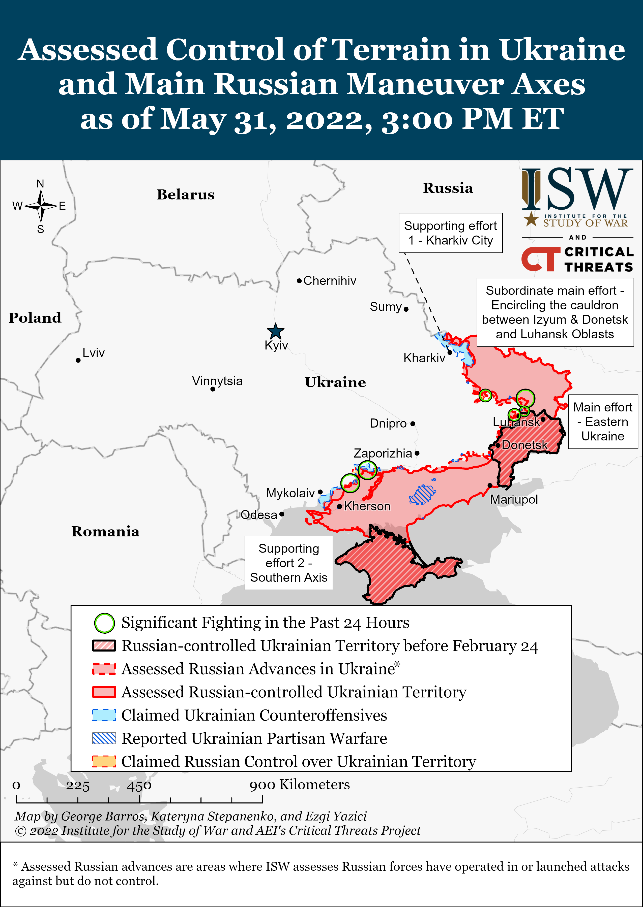
Sound Ukrainian prioritization of counter-offensive and defensive operations pushed the Russians almost out of artillery range of Kharkiv City and have stopped the Russian advances from Izium—both of which are more important accomplishments than the defense of Sievierodonetsk. Ukraine’s leadership has had to make incredibly difficult choices in this war and has generally made the right ones, at least at the level of strategic prioritization and in the pace, scale, and ambitiousness of its counter-offensives. That is why Ukraine still has a good chance to stop and then reverse the gains Russia is currently making.
Russian forces are likely attempting to exploit Belarusian equipment reserves to compensate for heavy material losses in Ukraine. The Ukrainian General Staff reported on May 31 that Belarusian forces are moving tanks and infantry fighting vehicles from storage facilities in Belarus to Russia to replenish combat losses. This report corroborates previous reporting that Russian forces have largely exhausted their own reserves and indicates that the Kremlin is still leveraging its influence over Belarus in order to use Belarusian equipment.
Some pro-Russian milbloggers began to capture the frustrating realities of limited warfare, which may further intensify societal tensions in Russia. Pro-Russian political figure and self-proclaimed “People’s Governor of Donetsk Oblast” Pavel Gubarev said that the limited mobilization of Russians for war has divided Russian society into two groups: a small proportion that is involved in the war and the “peacetime Russians” who distance themselves from the war effort and are inconvenienced by foreign sanctions. Gubarev blamed the “peacetime Russians” for failing to start collecting donations for Russian equipment, while criticizing the Kremlin for increasing propaganda about Russian successes during the “special military operation” in Ukraine. Gubarev also blamed the “peacetime Russians” for slowing down rotation rates due to fear of conscription. Gubarev noted that mass mobilization could resolve the divide in society but opined that Russian commanders will not order such a mobilization to avoid mass casualties of unprepared conscripts as occurred, he notes, in the Donetsk and Luhansk People’s Republics (DNR and LNR).
Gubarev is accurately capturing a phenomenon that is normal in a limited war that nevertheless generates high casualties. Resentment by those fighting such a war and their families against those who are untouched by the horrors of combat can grow even in an all-volunteer professional military, as Western countries experienced during the Iraq and Afghanistan wars. It is likely to be even more pronounced in Russia, whose military relies so heavily on conscripts and involuntarily-recalled reservists. This resentment can erode morale and will to fight as well as the propensity to volunteer for military service.
Key Takeaways
- Russian forces are increasingly focused on advancing on Sloviansk from the southeast of Izium and west of Lyman.
- Russian forces are making gains within and around Sievierodonetsk.
- Russian forces are likely hoping to advance on Lysychansk from Toshkivka in order to avoid having to fight across the Severskyi Donets River from Sievierodonetsk.
- The Russian grouping in Kherson Oblast is likely feeling the pressure of the limited Ukrainian counteroffensive in northwestern Kherson Oblast, especially as much of the Russian operational focus is currently on the capture of Sievierodonetsk.“
Only the fight will show whether we can repel a new attack from Belarus – Secretary of the National Security and Defence Council, Ukrainska Pravda reports. “We understand what is happening on the territory of Belarus; we are following the statements made by Lukashenko; we are aware of the threat that may exist from that side. Unfortunately, in addition to this decision (creation of a new southern operational command – ed.), Russian Iskanders [Iskander mobile short-range ballistic missile systems] are already stationed there, and the level of threat from that side is clear to us,” the Secretary of the National Security and Defence Council Oleksii Danilov in an interview with Ukrinform.
Russia’s army could collapse amid huge losses of more than 30,000 troops in Ukraine, according to a confidential UK report that emerged on Monday, Daily Mail reports.
“While Moscow’s latest estimated troop losses make grim reading for President Putin, the report claims he sees them as a ‘price worth paying’ for victory. However, the new report – a secretive analysis of Putin’s brutal invasion seen by The Mirror – claims that the losses could be too great for his soldiers, amid other reports that Russian morale is low. […] According to The Mirror, the new report suggests Kremlin officials have tried and failed to persuade Putin that his invasion has been a disaster and that he believes he can still achieve a partial victory in the eastern Donbas region of Ukraine.
A victory in the region would give Russia leverage over Kyiv, the report says, while defeat would likely result in Putin being ousted as president. […] On Monday, military analysts painted the battle as part of a race against time for the Kremlin, which they said wants to complete its capture of the industrial Donbas region before more Western arms arrive to bolster Ukraine’s defences.
According to The Mirror, the confidential report says: ‘Russia’s attempt to achieve a speedy and decisive victory in the Donbas has not yet succeeded. They are still grinding forward, gaining 1-2km a day. ‘The Russians are now achieving what successes they have mostly by means of a slogging match with repeated, very costly, infantry attacks reminiscent of 1945, not 2022.’ It goes on to say that so far, Putin has been able to mostly hide the ‘gross failures’ of the invasion from the Russian public, or blame them on other Kremlin officials.
‘The Russian population until recently bought Putin’s disinformation. We have seen an attempt within the Kremlin to get a message across to Putin and his closest team that things are going wrong, perhaps even catastrophically wrong,’ it adds. On the report, British Russia commentator Bruce Jones told The Mirror that there will eventually come a point where Putin’s forces can no longer sustain any more losses. ‘This would be a straw that broke the camel’s moment, where units would no longer be able to function as a fighting force because they are so depleted,’ he said. […]
Sievierodonetsk and Lysychansk sit on either side of the strategically important Siverskiy Donetsk River – and the Russian advance on the cities is part of an all-out push – executed without regard for personnel and equipment losses, said Ukrainian military analyst Oleh Zhdanov. ‘There is an impression that Russia has set the goal to seize Donbas at any cost,’ said Zhdanov.
‘The Kremlin has reckoned that it can’t afford to waste time and should use the last chance to extend the separatist-controlled territory because the arrival of Western weapons in Ukraine could make it impossible.’ But in a potential setback for Ukraine, President Joe Biden appeared to dismiss reports that the US was considering sending long-range rocket systems to the country. […] The Ukrainians hope they can hold the Russians off long enough for them to run out of steam – or for more Western weapons to arrive. Ukrainian officials have warned of the dire cost if more help does not arrive soon. […]
Mykola Sunhurovskyi, a military expert at the Kyiv-based Razumkov Center think tank, said weapons are taking a long time to arrive – given the Russians an opening to take advantage of the slow delivery and make up for difficulties its forces had earlier in the war. ‘Russia clearly has been trying to take revenge for its past failures in Ukraine and achieve at least some of its goals,’ Sunhurovskyi said.”

